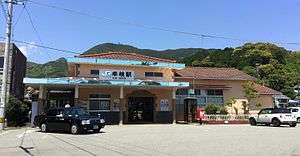Mugi Station
Mugi Station (牟岐駅, Mugi-eki) is a railway station on the Mugi Line in Mugi, Kaifu District, Tokushima Prefecture, Japan. It is operated by JR Shikoku and has the station number "M24".[1][2]
Mugi Station 牟岐駅 | |
|---|---|
 Mugi Station in May 2016 | |
| Location | Nakamura, Mugi-cho, Kaifu-gun, Tokushima-ken 775-0006 Japan |
| Coordinates | 33.6725°N 134.4179°E |
| Operated by | |
| Line(s) | ■ Mugi Line |
| Distance | 67.7 km from Tokushima |
| Platforms | 1 island platform |
| Tracks | 2 + 2 passing loops + 2 sidings |
| Construction | |
| Structure type | At grade |
| Parking | Available |
| Disabled access | Yes - platforms linked by ramps and level crossing |
| Other information | |
| Status | Staffed - JR ticket window |
| Station code | M24 |
| Website | Official website |
| History | |
| Opened | 1 July 1942 |
| Location | |
 Mugi Station Location within Japan | |
Lines
The station is served by the Mugi Line and is located 67.7 km from the beginning of the line at Tokushima.[3] Besides the local trains on the Mugi Line, the station is also the southern terminus for the Muroto limited express service between it and Tokushima.[4]
Layout
The station consists of an island platform serving two tracks. As the station was until 1973 the southern terminus of the Mugi line, numerous passing loops and sidings branch off from the main tracks. The station building houses a waiting room and a JR ticket window (without a Midori no Madoguchi facility).[5] Access to the island platform is by means of a level crossing with ramps.[2][3][6]
- Waiting room and ticket window of Mugi Station.
- A view of the station platforms and tracks. There is a passing loop to the left between track 1 and the station building. To the right of track 2 is another passing loop and various sidings. Note the level crossing at the far end of the platform.
 Historic photo taken on the day the station was opened. Note the station building in the background. There was, at the time, a footbridge linking to the platforms.
Historic photo taken on the day the station was opened. Note the station building in the background. There was, at the time, a footbridge linking to the platforms.
Adjacent stations
| « | Service | » | ||
|---|---|---|---|---|
| JR Limited Express Services | ||||
| Hiwasa | Muroto | Terminus | ||
| Mugi Line | ||||
| Hegawa | Local | Sabase | ||
History
Japanese Government Railways (JGR) opened the station on 1 July 1942 as the terminus of the Mugi Line which had been extended southwards from Hiwasa. Mugi was the southern terminus of the line until 1 October 1973 when the line was extended further south to Kaifu. On 1 April 1987, with the privatization of Japanese National Railways (JNR), the successor of JGR, control of the station passed to JR Shikoku.[7][8]
See also
References
- "Shikoku Railway Route Map" (PDF). JR Shikoku. Retrieved 23 December 2017.
- "牟岐" [Mugi Station]. hacchi-no-he.net. Retrieved 14 February 2018.
- Kawashima, Ryōzō (2013). 図説: 日本の鉄道 四国・九州ライン 全線・全駅・全配線・第1巻 四国東部エリア [Japan Railways Illustrated. Shikoku and Kyushu. All lines, all stations, all track layouts. Volume 1 Eastern Shikoku] (in Japanese). Kodansha. pp. 43, 73. ISBN 9784062951609.
- "Mugi Station Timetable" (PDF). JR Shikoku. Retrieved 14 February 2018.
- "JR四国の駅 窓口営業時間一覧" [JR Shikoku station ticket window opening hours list] (PDF). JR Shikoku. 28 November 2017. Archived from the original (PDF) on 18 March 2018. Retrieved 2 February 2018.
- "牟岐駅" [Mugi Station]. shikoku.org.uk. Retrieved 14 February 2018.
- Ishino, Tetsu; et al., eds. (1998). 停車場変遷大事典 国鉄・JR編 [Station Transition Directory - JNR/JR] (in Japanese). II. Tokyo: JTB Corporation. p. 662. ISBN 4533029809.
- Ishino, Tetsu; et al., eds. (1998). 停車場変遷大事典 国鉄・JR編 [Station Transition Directory - JNR/JR] (in Japanese). I. Tokyo: JTB Corporation. p. 217. ISBN 4533029809.
| Wikimedia Commons has media related to Mugi Station (Tokushima). |